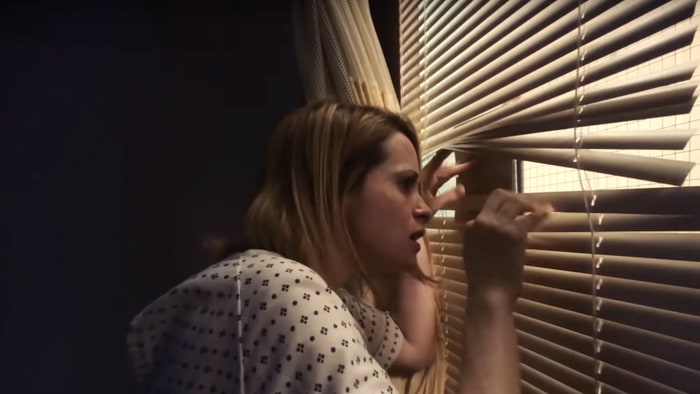10 days, $1.2 million, 98 minutes. That’s how Steven Soderbergh made his latest film, “Unsane.”
If you’re unfamiliar with the director’s resume, he entered the world of cinema in 1989, with the film “Sex, Lies and Videotape.” Since then, he’s masterminded movies like “Ocean’s Eleven” and “Magic Mike.”
Adjectives like “daring” and “ingenious” tend to casually pop up in conversation when critics describe the director’s films. Despite my hesitance to idol-worship anyone, I’m inclined to agree. Even at his most conventional, the director retains the sentiment that beats in the heart of independent cinema: the desire to push forward, take chances and break new ground.
From the artsy action-thriller “Haywire” to the peculiar hilarity of “Logan Lucky,” the filmmaker seemingly has an allergy to repetition. While certain stylistic flourishes carry over, most comparisons drawn between projects stop there.
“Unsane” is possibly his boldest film to date. Shot completely on an iPhone 7 Plus over the course of 10 days, the psychological thriller stars Claire Foy as Sawyer Valentini, a woman who finds herself committed to a mental institution while attempting to escape her stalker. Does she need to be there? The audience finds out bit by bit over the 98-minute runtime.
Despite those stylistic risks, the film is with watching for the sheer enjoyment of it. It’s subversive, captivating and taut with tension and I can almost guarantee it’s one of the best films you’ll see in 2018. However, the magic behind the camera is what I believe to be most thought-provoking, as it crafts a blueprint that aspiring filmmakers need to take note of.
Craft Your Characters
In my opinion, characters and dialogue drive films more than any other creative element. They’re the reason why Darth Vader’s “I am your father” is more than an arbitrary statement. They’re why everyone remembers that we can’t talk about Fight Club.
Sure, I enjoy a bit of mindless action every once and a while, but there’s a reason I prefer the “Fast and Furious” franchise over the “Transformers” saga. Despite the absurdity of the plotlines, the “Fast and Furious” films have endearing, true-to-life characters. It’s the main reason why the franchise keeps drawing me back, sequel after unnecessary sequel.
The same goes for “Unsane.” This isn’t a great movie because it’s shot on an iPhone; it’s a great movie that just so happens to be shot on an iPhone.
If you strip this film of its characters, you’re left with a gimmicky, derivative horror film that loses steam after the first act. Sure, it was interesting to see what a movie shot on an iPhone looks like, but styles can only carry you so long before the gimmick gets old. If the audience can’t believe that Sawyer is a real person facing actual dangers, then the movie fails entirely.
Let the audience get to know your characters. Make them care. You’re not obligated to write someone likable; “Nightcrawler” and “Good Time,” among countless others, feature extremely flawed protagonists that nevertheless hold your attention. Just make sure they’re believable.
The worst crime a movie can commit is boredom. If you invest your stock in characters, however, you’re less likely to commit it.
Take Chances and Trust the Audience
The buzzword surrounding “Unsane” is “experimental,” and Soderbergh is no stranger to experimentation. For instance, the cast of his film “Bubble” consisted entirely of non-actors. Meanwhile, the main star of “The Girlfriend Experience” is adult-film actress Sasha Grey — two dicey choices for any filmmaker.
While “Unsane” is the very definition of risk, the film never crosses over into avant-garde territory or alienates the viewers. It consistently keeps the audience in mind and delivers on genre tropes while simultaneously flipping expectations on their heads. This is a hard duality to balance, yet the movie passes with flying colors.
Don’t be afraid to toy around with ideas. You shouldn’t automatically assume audiences will avoid your film simply because it asks something of them. Your viewers aren’t stupid, and they don’t like to be treated as such.
Of course, that’s not to say you should make a pseudo-documentary about a time-traveling vegetable thief told solely through interpretive dance. When trying not to spoon-feed your audience, you can still overcompensate by expecting your viewers to eat an eight-course meal using only their hands.
So please, experiment all you want, but don’t be weird for the sake of being weird. If your flair has a purpose, then go ahead, but people can smell out pretention far easier than many give them credit for, so tread lightly.
Start Small
$1.2 million is a lifetime of wealth for the average American. For Hollywood, it’s chump change. To put this in perspective, the budget of “Ready Player One” is $175 million, while “Black Panther” cost approximately $200 million to make. “Unsane,” for Hollywood, is the equivalent of buying a pack of gum.
The film’s business model is arguably the most groundbreaking aspect of the entire product. If the movie wins the hearts of audiences, the studio turns a substantial profit.
Even if the film flops, though, the studio’s gains based on ticket sales alone are usually several times the initial budget. As of March 29, “Unsane” has made approximately $6 million. In the eyes of the studio, that’s a huge success.
Furthermore, Soderbergh’s film keeps it to a minimum when it comes to scale, which adds to the realism. There’s a distinct lack of spectacle and set-pieces, and about 90 percent of the movie takes place in a mental institution. The film is simple and all the better for it.
Countless directors began their careers creating small-scale, intimate films before venturing into the mainstream realm. The best examples I can provide are Rian Johnson and James Gunn.
Before he helmed “The Last Jedi,” Johnson’s directorial debut was “Brick,” a neo-noir mystery set in high school. Starring Joseph Gordon-Levitt in one of his earliest main roles, “Brick” cost less than $500,000 to make and starred Joseph Gordon-Levitt in one of his earliest main roles. And, just for the record, it’s one of my all-time favorite films.
Similarly, Gunn released his sophomore film “Super” in 2010. The dark comedy, starring Rainn Wilson — better known as Dwight from “The Office” — cost $2.5 million to make and saw a $400,000 return. In 2014, Gunn wrote and directed “Guardians of the Galaxy.” Conversely, the Marvel film earned $773.3 million worldwide.
If “Unsane” cannot convince aspiring filmmakers that expensive, industry-grade equipment isn’t mandatory, I don’t know what will. Take advantage of the tools at your disposal right now.
Audiences don’t watch movies just to gaze at lens flares and crane shots. If given the choice between an engaging story with believable characters shot on an iPhone and a sci-fi epic featuring shallow typecasts filmed with a multi-thousand-dollar camera, I’ll take the former any day of the week.
In a market oversaturated with sequels, remakes and adaptations, the likelihood of a spec script — a screenplay not based on a pre-existing property — gaining any traction is slim to none. For all extensive purposes, “Unsane” should not exist — but I’m so glad it does.
The film is a masterclass for future filmmakers. Nevertheless, I encourage you to watch the film, even if you don’t plan on going in filmmaking. If “Unsane” is the start of a trend where directors begin incorporating technological advancements into their films as a means of moving the medium forward, I’m all for it.
Does it run the risk of altering the perception of the artform as a whole? Possibly. But maybe that’s a good thing.

















